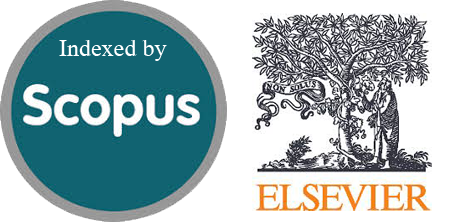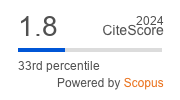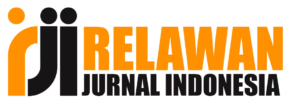Capturing Students’ Dynamic Learning Pattern Based on Activity Logs Using Hierarchical Clustering
Abstract
Students can have various characteristics and learning patterns. By understanding the characteristics and learning pattern of individual students, teachers can provide individualized learning strategies based on students' needs. Students' learning patterns may experience changes depending on their conditions during the learning process. If the learning pattern analysis is only run once, then the progress and changes in student learning patterns throughout the learning process cannot be recognized. On the other hand, periodical analysis is expected to describe the dynamics of student learning patterns from time to time. This research is intended for capturing students' dynamic learning pattern using Hierarchical Clustering. We clustered the learning patterns based on Learning Management Systems (LMS) activity logs. The activity log data were partitioned into several periodical datasets. The results of the periodic clustering indicated that students’ learning patterns varied from one another and changed from time to time. Most students experienced change in learning patterns throughout the semester. The analysis also indicated that learning pattern also has the potential to be improved and maintained.
Downloads
References
K. A. Laksitowening, H. B. Santoso, and Z. A. Hasibuan, “E-Learning Personalization Using Triple-Factor Approach in Standard-Based Education,” J. Phys. Conf. Ser., vol. 801, no. 1, 2017, doi: 10.1088/1742-6596/801/1/012027.
I. Šarić-Grgić, A. Grubišić, L. Šerić, and T. J. Robinson, “Student clustering based on learning behavior data in the intelligent tutoring system,” Int. J. Distance Educ. Technol., vol. 18, no. 2, pp. 73–89, 2020, doi: 10.4018/IJDET.2020040105.
Q. Liu and G. Fan, “Using Learning Analytics Technologies to Find Learning Structures from Online Examination System,” 2014, doi: 10.1109/EITT.2014.38.
M. Pechenizkiy and D. Gasevic, “Introduction into Sparks of the Learning Analytics Future,” J. Learn. Anal., vol. 1, no. 3, pp. 145–149, 2015.
S. N. Kew and Z. Tasir, “Learning Analytics in Online Learning Environment: A Systematic Review on the Focuses and the Types of Student-Related Analytics Data,” Technol. Knowl. Learn., vol. 27, no. 2, pp. 405–427, 2022, doi: 10.1007/s10758-021-09541-2.
D. Ifenthaler and J. Y. K. Yau, “Utilising learning analytics to support study success in higher education: a systematic review,” Educ. Technol. Res. Dev., vol. 68, no. 4, pp. 1961–1990, 2020, doi: 10.1007/s11423-020-09788-z.
A. D. Samala et al., “Learn Algorithm and Programming in Higher Education Using E-Learning During the COVID-19 Pandemic: Students’ Perspective,” in Proceedings of the 8th International Conference on Technical and Vocational Education and Training (ICTVET 2021), 2021. doi: dx.doi.org/10.2991/assehr.k.211208.017.
V. Kovanovic, C. Mazziotti, and J. Lodge, “Learning analytics for primary and secondary schools,” J. Learn. Anal., vol. 8, no. 2, pp. 1–5, 2021, doi: 10.18608/JLA.2021.7543.
D. Ye, “The History and Development of Learning Analytics in Learning, Design, & Technology Field,” TechTrends, vol. 66, no. 4, pp. 607–615, 2022, doi: 10.1007/s11528-022-00720-1.
E. Afari, “Myint Swe Khine (Ed.): Emerging trends in learning analytics: leveraging the power of education data (Contemporary approaches to research in learning innovations, volume 12),” Learn. Environ. Res., vol. 23, no. 1, pp. 151–152, 2020, doi: 10.1007/s10984-020-09309-y.
M. Riestra-González, M. del P. Paule-Ruíz, and F. Ortin, “Massive LMS log data analysis for the early prediction of course-agnostic student performance,” Comput. Educ., vol. 163, no. January, 2021, doi: 10.1016/j.compedu.2020.104108.
S. Mojarad, A. Essa, S. Mojarad, and R. S. Baker, “Data-driven learner profiling based on clustering student behaviors: Learning consistency, pace and effort,” Lect. Notes Comput. Sci. (including Subser. Lect. Notes Artif. Intell. Lect. Notes Bioinformatics), vol. 10858 LNCS, no. May, pp. 130–139, 2018, doi: 10.1007/978-3-319-91464-0_13.
R. Watrianthos, R. Hasibuan, D. Rimbano, N. Jalinus, and R. Abdullah, “Effectiveness Blended Learning During Pandemic in Indonesia: A Meta-Analysis,” Jurnal Pendidikan MIPA, vol. 22, no. 2, pp. 270–278, 2021, doi: 10.23960/jpmipa/v22i2.pp270-278.
M. Kokoç, G. Akçapınar, and M. N. Hasnine, “Unfolding Students’ Online Assignment Submission Behavioral Patterns Using Temporal Learning Analytics,” Educ. Technol. Soc., vol. 24, no. 1, pp. 223–235, 2021.
G. Fenu and R. Galici, “Modelling student behavior in synchronous online learning during the covid-19 pandemic,” CEUR Workshop Proc., vol. 2876, pp. 28–40, 2021.
A. Van Leeuwen, S. D. Teasley, and A. F. Wise, “Teacher and Student Facing Learning Analytics,” Handb. Learn. Anal., pp. 130–140, 2022, doi: 10.18608/hla22.013.
D. Hooshyar, Y. Yang, M. Pedaste, and Y. M. Huang, “Clustering Algorithms in an Educational Context: An Automatic Comparative Approach,” IEEE Access, vol. 8, pp. 146994–147014, 2020, doi: 10.1109/ACCESS.2020.3014948.
Ni Putu Viona Viandari, I Made Agus Dwi Suarjaya, and I Nyoman Piarsa, “Pemetaan Pelanggan dengan LRFM dan Two Stage Clustering untuk Memenuhi Strategi Pengelolaan,” J. RESTI (Rekayasa Sist. dan Teknol. Informasi), vol. 6, no. 1, pp. 130–139, 2022, doi: 10.29207/resti.v6i1.3778.
J. N. Walsh and A. Rísquez, “Using cluster analysis to explore the engagement with a flipped classroom of native and non-native English-speaking management students,” Int. J. Manag. Educ., vol. 18, no. 2, p. 100381, 2020, doi: 10.1016/j.ijme.2020.100381.
T. Zhang, M. Taub, and Z. Chen, “A Multi-Level Trace Clustering Analysis Scheme for Measuring Students’ Self-Regulated Learning Behavior in a Mastery-Based Online Learning Environment,” ACM Int. Conf. Proceeding Ser., pp. 197–207, 2022, doi: 10.1145/3506860.3506887.
S. L. S. López, R. P. D. Redondo, and A. F. Vilas, “Discovering knowledge from student interactons: Clustering vs classificaton,” ACM Int. Conf. Proceeding Ser., vol. Part F1322, 2017, doi: 10.1145/3144826.3145390.
K. Palani, P. Stynes, and P. Pathak, “Clustering Techniques to Identify Low-engagement Student Levels,” Int. Conf. Comput. Support. Educ. CSEDU - Proc., vol. 2, no. Csedu, pp. 248–257, 2021, doi: 10.5220/0010456802480257.
X. Yin, “Construction of Student Information Management System Based on Data Mining and Clustering Algorithm,” Complexity, vol. 2021, 2021, doi: 10.1155/2021/4447045.
A. A. O, K. K. Kolawole, A. Oluwole, and B. W. Adebayo, “Performance evaluation of student academic results using clustering,” vol. 2, no. 1, pp. 36–40, 2021.
I. Vhallah, S. Sumijan, and J. Santony, “Pengelompokan Mahasiswa Potensial Drop Out Menggunakan Metode Clustering K-Means,” J. RESTI (Rekayasa Sist. dan Teknol. Informasi), vol. 2, no. 2, pp. 572–577, 2018, doi: 10.29207/resti.v2i2.308.
M. Milivojevic, S. Obradovic, A. K. Malisic, and S. Petrovic, “Analysis of Student Dropout At Western Serbia Academy of Applied Studies : a Clustering Based Approach.”
V. Kovanović, T. Hennis, S. Joksimović, S. Dawson, O. Poquet, and D. Gašević, “Understanding the relationship between technology use and cognitive presence in MOOCs,” ACM Int. Conf. Proceeding Ser., pp. 582–583, 2017, doi: 10.1145/3027385.3029471.
S. N. Safitri, H. Setiadi, and E. Suryani, “Educational Data Mining Using Cluster Analysis Methods and Decision,” J. RESTI (Rekayasa Sist. dan Teknol. Informasi), vol. 6, no. 3, pp. 448–456, 2022.
R. A. Pazmiñ o-Maji, F. J. Garcíá-Peñ alvo, and M. A. Conde-González, “Comparing Hierarchical Trees in Statistical Implicative Analysis & Hierarchical Cluster in Learning Analytics,” ACM Int. Conf. Proceeding Ser., vol. 2017-Janua, pp. 1–7, 2017, doi: 10.1145/3144826.3145399.
Pelsri Ramadar Noor Saputra and A. Chusyairi, “Perbandingan Metode Clustering dalam Pengelompokan Data Puskesmas pada Cakupan Imunisasi Dasar Lengkap,” J. RESTI (Rekayasa Sist. dan Teknol. Informasi), vol. 4, no. 6, pp. 5–12, 2020, doi: 10.29207/resti.v4i6.2556.
R. Ananda and A. Z. Yamani, “Penentuan Centroid Awal K-Means pada Proses Clustering Data Evaluasi,” J. RESTI (Rekayasa Sist. dan Teknol. Informasi), vol. 1, no. 10, pp. 544–550, 2021.
T. Susilowati, D. Sugiarto, and I. Mardianto, “Uji Validasi Algoritmaa Self-Organizing Map (SOM) dan K-Means untukPengelompokan Pegawai,” Rekayas a Sist. dan T eknol ogi Inf. , vol. 4, no. 6, pp. 1171–1178, 2020.
Copyright (c) 2023 Jurnal RESTI (Rekayasa Sistem dan Teknologi Informasi)

This work is licensed under a Creative Commons Attribution 4.0 International License.
Copyright in each article belongs to the author
- The author acknowledges that the RESTI Journal (System Engineering and Information Technology) is the first publisher to publish with a license Creative Commons Attribution 4.0 International License.
- Authors can enter writing separately, arrange the non-exclusive distribution of manuscripts that have been published in this journal into other versions (eg sent to the author's institutional repository, publication in a book, etc.), by acknowledging that the manuscript has been published for the first time in the RESTI (Rekayasa Sistem dan Teknologi Informasi) journal ;








